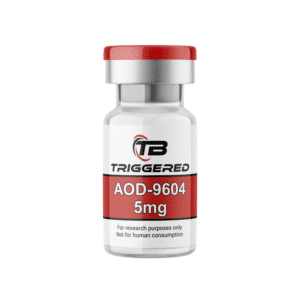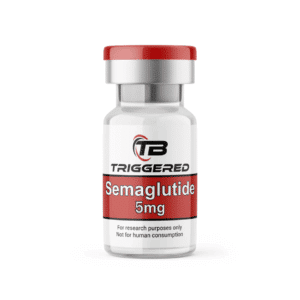4 Best Peptides For Weight Loss 2023
In the realm of biochemistry, peptides have emerged as potent tools in the fight against excess weight. These serve as the building blocks of proteins that deliver promising results in promoting fat loss and enhancing metabolic health.
For those in the vibrant and diverse locale of Thailand, acquiring peptides has become increasingly accessible. Due to the country’s progressive stance on research and medicinal compounds, it’s possible to buy peptides in Thailand from reputable sources, ensuring quality and authenticity.
In this exploration, we’ll dive deep into the top 4 peptides that have proven their mettle in the weight loss arena.
AOD 9604
AOD-9604 is a peptide that was initially developed for the treatment of obesity. Its sequence is derived from the C-terminus of human growth hormone (hGH) spanning amino acids 177-191, hence it’s sometimes referred to as the “lipolytic fragment.” AOD-9604 has been shown to have several properties, including the stimulation of lipolysis (fat breakdown) and the inhibition of lipogenesis (fat accumulation).
Weight Loss and Fat Reduction:
Some early studies indicated that AOD-9604 could lead to reductions in body fat without the adverse side effects associated with full-length hGH. The peptide seemed to target fat cells and accelerate fat metabolism, thereby potentially aiding in weight loss.
No Influence on Muscle Mass:
Unlike hGH, which can increase both muscle mass and fat metabolism, AOD-9604 appears to target only fat metabolism, without increasing muscle mass. This selectivity was deemed an advantage, given the concerns with muscle and bone growth seen with hGH.
Safety:
The safety profile of AOD-9604 appears to be good, with no evidence of the side effects commonly associated with hGH, like diabetes, blood pressure issues, or unwanted bone growth.
Semaglutide
Semaglutide is a glucagon-like peptide-1 (GLP-1) receptor agonist initially developed for the treatment of type 2 diabetes. GLP-1 is a hormone released from the intestines in response to food intake and has multiple actions. It includes enhancing insulin secretion, decreasing glucagon release, and slowing gastric emptying.
Besides, GLP-1 has been found to reduce appetite, and this has prompted interest in its potential as a weight loss agent.
Clinical Trials:
In addition to its glucose-lowering effect, semaglutide can induce significant weight loss. In these studies, participants on semaglutide, compared to those on placebo, achieved more substantial reductions in body weight.
Mechanism of Action:
The exact mechanism by which semaglutide promotes weight loss isn’t entirely clear but likely involves its action on the brain, specifically areas that regulate appetite. By activating GLP-1 receptors in these areas, semaglutide appears to reduce hunger and increase feelings of fullness.
FDA Approval for Obesity:
Given the promising results from clinical trials, semaglutide has been approved by the U.S. Food and Drug Administration (FDA) not only for the treatment of type 2 diabetes but also for chronic weight management in adults with obesity or overweight with at least one weight-related condition (like hypertension or type 2 diabetes).
Side Effects:
Common side effects of semaglutide include nausea, diarrhea, vomiting, and constipation. These gastrointestinal symptoms are also observed with other GLP-1 receptor agonists. Most side effects are mild to moderate and tend to diminish over time.
Tirzepatide
Tirzepatide is a novel investigational medication that is developed for the treatment of type 2 diabetes and potentially for the treatment of obesity. It’s a dual glucose-dependent insulinotropic polypeptide (GIP) and glucagon-like peptide-1 (GLP-1) receptor agonist.
Mechanism of Action:
Tirzepatide combines the actions of both GIP and GLP-1. These incretin hormones are naturally occurring in the body and help regulate glucose metabolism.
By mimicking the effects of these hormones, tirzepatide enhances insulin secretion, reduces glucagon secretion, and slows gastric emptying. These combined effects can help improve glycemic control and potentially reduce body weight.
Administration:
Tirzepatide, as of my last update, is administered through subcutaneous injection. This means it’s given as a shot under the skin, similar to how many current diabetes medications, like insulin or GLP-1 receptor agonists, are given.
Comparison with Other Treatments:
Tirzepatide, being a dual GIP and GLP-1 receptor agonist, represents a new class of glucose-lowering drugs. Initial results suggest it may provide advantages over current treatments in terms of efficacy. However, direct head-to-head comparisons with existing medications will be needed to establish its exact place in the treatment paradigm.
Use in Other Conditions:
While the primary focus has been on type 2 diabetes and obesity, research may expand to investigate the utility of tirzepatide in other metabolic disorders or conditions.
Cost and Accessibility:
If approved, the cost and accessibility of tirzepatide would be key factors influencing its uptake. Many novel drugs are initially expensive, and insurance coverage, patient assistance programs, and other mechanisms might determine its affordability for patients.
Tesamorelin
Tesamorelin is a synthetic form of growth-hormone-releasing hormone (GHRH), a naturally occurring human hormone that stimulates the production and release of growth hormone.
It was developed and has been approved specifically to reduce excess visceral abdominal fat in HIV-infected patients with lipodystrophy, a condition where abnormal fat deposits occur, especially around the abdomen. Lipodystrophy in HIV patients is believed to be linked to certain antiretroviral therapies.
Efficacy:
Clinical trials have demonstrated that tesamorelin can significantly reduce visceral abdominal fat in HIV-infected patients with lipodystrophy. However, the effect of tesamorelin on subcutaneous fat (fat under the skin) is less pronounced.
Mechanism of Action:
By mimicking the effects of GHRH, tesamorelin stimulates the release of growth hormone from the pituitary gland. Growth hormone plays a role in fat metabolism, among its many other functions.
Use for General Weight Loss:
The primary indication for tesamorelin is for HIV-associated lipodystrophy. It is approved for general weight loss in the broader population, and its efficacy for this purpose hasn’t been well-established.
Side Effects:
Common side effects associated with tesamorelin include joint pain, skin rash, muscle pain, and swelling due to fluid retention. There’s also a potential risk for elevated blood sugar levels, so it might not be suitable for individuals with diabetes.
Final Thoughts:
For individuals and professionals keen on exploring these bioactive compounds, Thailand offers a promising destination. With its forward-thinking approach to research and medicinal compounds, one can buy peptides in Thailand with confidence, ensuring they’re receiving high-quality products.













